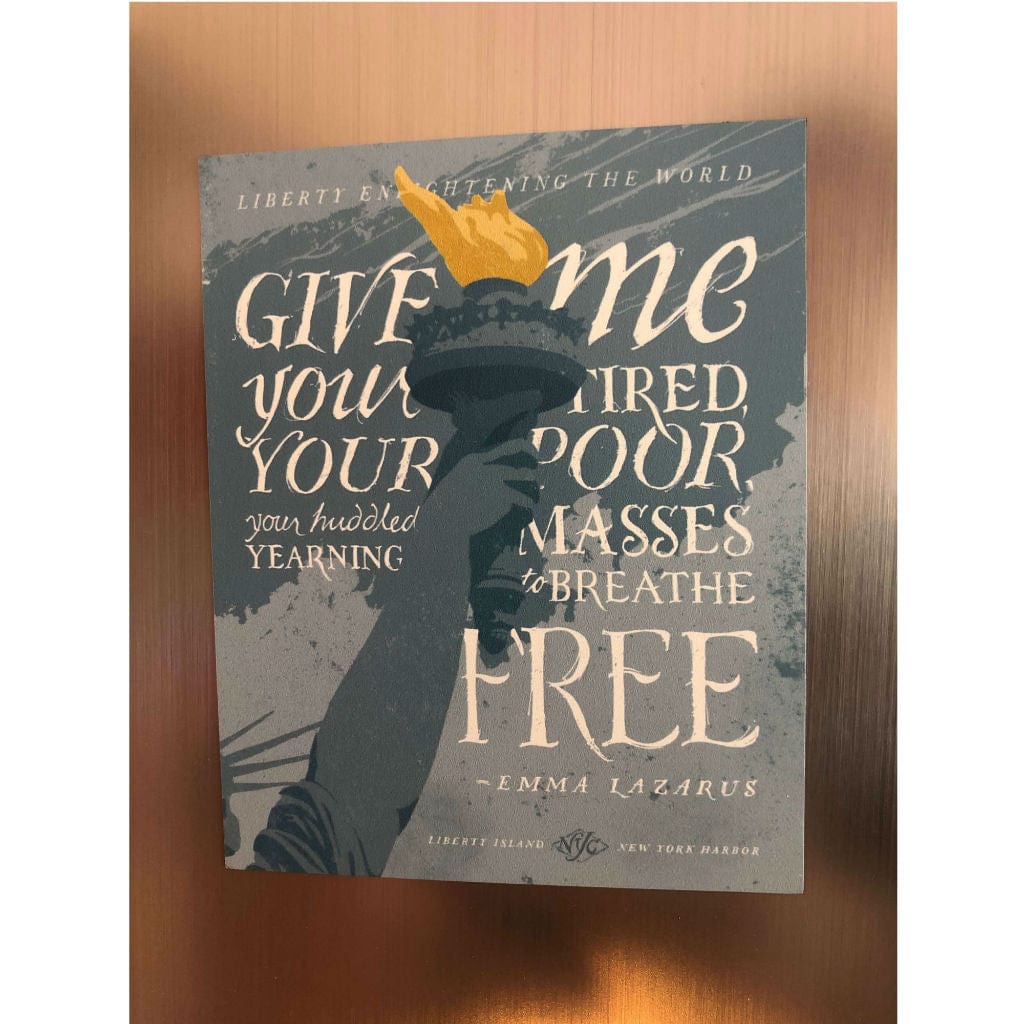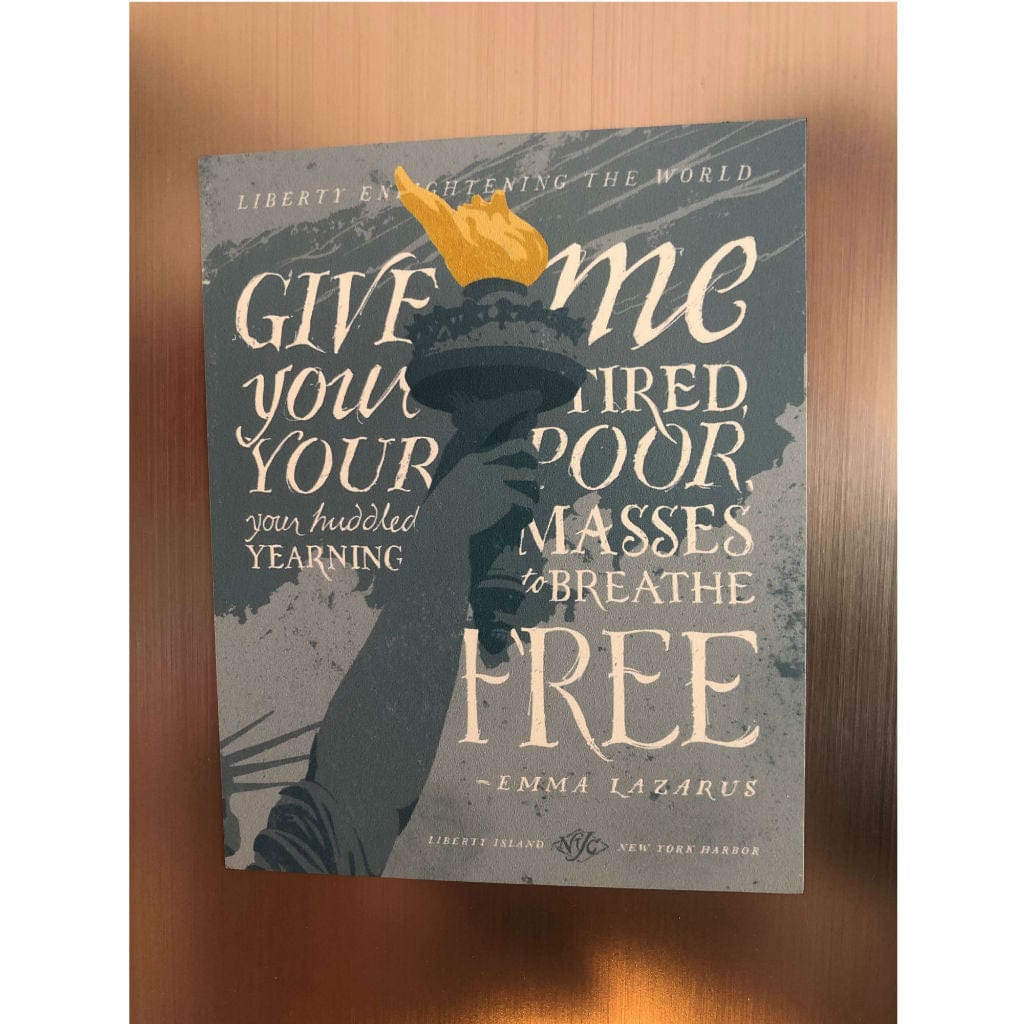The History List |
"Liberty Enlightening the World" Magnet, with the Statue of Liberty
"Liberty Enlightening the World" Magnet, with the Statue of Liberty
Couldn't load pickup availability

Original art created by Larry Stuart. Printed on a thin, flexible magnet.
Size: 3.21" x 4"
View our collection of stickers, magnets, bookmarks, and patches.
Historical Background Behind the Design: Liberty Enlightening the World
"The Statue of Liberty was a gift from the French people commemorating the alliance of France and the United States during the American Revolution. Yet, it represented much more to those individuals who proposed the gift.
"In 1865, Edouard de Laboulaye(a French political thinker, U.S. Constitution expert, and abolitionist) proposed that a monument be built as a gift from France to the United States in order to commemorate the perseverance of freedom and democracy in the United States and to honor the work of the late president Abraham Lincoln.
"Laboulaye hoped that by calling attention to the recent achievements of the United States, the French people would be inspired to create their own democracy in the face of a repressive monarchy. In 1865, France was divided between people who were still committed to the monarchy and people who supported the Enlightenment ideals (the belief that people had natural rights to life, liberty, and the pursuit of happiness). It was the hope of many French liberals that democracy would prevail and that freedom and justice for all would be attained. . . .
"'Liberty' was a controversial idea in the 19th century. To many people it suggested violence and revolution. Laboulaye and Bartholdi agreed that their monument should not be seen as leading an uprising, but rather as lighting the way, peacefully and lawfully. A key element was the name they gave to the Statue: Liberty Enlightening the World. Bartholdi's public monuments hailed back to classical images of a powerful, honorable national authority over any ideology. His statue of "Liberty Enlightening the World" would be above conservatism and liberalism and above radical revolutions and political turmoil. She would be an international symbol of liberty, justice, and democracy. In 1871, the Statue was transformed from idea into reality - it was to be funded, built, and presented to the United States." (1)
Building the statue and the pedestal
"It was agreed that the American people were to build the pedestal, and the French people were responsible for the Statue and its assembly here in the United States.
"However, lack of funds was a problem on both sides of the Atlantic Ocean. In France, public fees, various forms of entertainment, and a lottery were among the methods used to raise funds. In the United States, benefit theatrical events, art exhibitions, auctions and prizefights assisted in providing needed funds. Poet Emma Lazarus wrote her famous sonnet “The New Colossus” in 1883 for the art and literary auction to raise funds for the Statue's pedestal.
"Meanwhile in France, Bartholdi required the assistance of an engineer to address structural issues associated with designing such a colossal copper sculpture. Alexandre Gustave Eiffel (designer of the Eiffel Tower) was commissioned to design the massive iron pylon and secondary skeletal framework which allows the Statue's copper skin to move independently yet stand upright.
"Back in America, fundraising for the pedestal was going particularly slowly, so Joseph Pulitzer opened up the editorial pages of his newspaper, "The World," to support the fundraising effort. Pulitzer used his newspaper to criticize both the rich who had failed to finance the pedestal construction and the middle class who were content to rely upon the wealthy to provide the funds. Pulitzer's campaign of harsh criticism was successful in motivating the people of America to donate.
"Architect Richard Morris Hunt designed the Statue of Liberty's granite pedestal in 1884, donating his fee to help fund the Statue. Financing for the pedestal was completed in August 1885, and pedestal construction was finished in April 1886. The Statue was completed in France in July 1884 and arrived in New York Harbor in June 1885 onboard the French frigate "Isere."
"In transit, the Statue was reduced to 350 individual pieces and packed in 214 crates. The Statue was reassembled on her new pedestal in four months’ time. On October 28, 1886, President Grover Cleveland oversaw the dedication of the Statue of Liberty in front of thousands of spectators. She was a centennial gift ten years late.
"The story of the Statue of Liberty and her island has been one of change. With the placing of “The New Colossus” on a plaque in the pedestal in 1903, Lady Liberty’s significance grew as an inspiration to immigrants who sailed past her on their way to America. The Statue was placed upon a granite pedestal inside the courtyard of the star-shaped walls of Fort Wood (which had been completed for the War of 1812). (2)
A poem to help raise money for construction of the pedestal
"This poem was written as a donation to an auction of art and literary works conducted by the "Art Loan Fund Exhibition in Aid of the Bartholdi Pedestal Fund for the Statue of Liberty" to raise money for the pedestal's construction. Lazarus's contribution was solicited by fundraiser William Maxwell Evarts. Initially she refused, but writer Constance Cary Harrison convinced her that the statue would be of great significance to immigrants sailing into the harbor.
"'The New Colossus' was the first entry read at the exhibit's opening on November 2, 1883. It remained associated with the exhibit through a published catalog until the exhibit closed after the pedestal was fully funded in August 1885, but was forgotten and played no role at the opening of the statue in 1886. It was, however, published in Joseph Pulitzer's New York World as well as The New York Times during this time period. In 1901, Lazarus's friend, Georgina Schuyler, began an effort to memorialize Lazarus and her poem, which succeeded in 1903 when a plaque bearing the text of the poem was put on the inner wall of the pedestal of the Statue of Liberty
"Not like the brazen giant of Greek fame,
With conquering limbs astride from land to land;
Here at our sea-washed, sunset gates shall stand
A mighty woman with a torch, whose flame
Is the imprisoned lightning, and her name
MOTHER OF EXILES. From her beacon-hand
Glows world-wide welcome; her mild eyes command
The air-bridged harbor that twin cities frame.
"Keep, ancient lands, your storied pomp!" cries she
With silent lips. "Give me your tired, your poor,
Your huddled masses yearning to breathe free,
The wretched refuse of your teeming shore.
Send these, the homeless, tempest-tost to me,
I lift my lamp beside the golden door!" . . . .
The references in the poem
"The title of the poem and the first two lines refer to the Colossus of Rhodes, one of the Seven Wonders of the Ancient World, sometimes described as standing astride the harbor.
"The 'sea-washed, sunset gates' are the mouths of the Hudson and East Rivers, to the west of Brooklyn. The 'imprisoned lightning' refers to the electric light in the torch, then a novelty.
"The 'air-bridged harbor that twin cities frame' refers to New York Harbor between New York City and Brooklyn, which were consolidated into one unit in 1898, 15 years after the poem was written.
"The 'huddled masses' are the many immigrants coming to the United States (many of them through Ellis Island at the port of New York)." (3)
Sources: (1) National Park Service; (2) The Statue of Liberty Ellis Island Foundation; and, (3) Wikipedia
"Statue of Liberty" art © 2018 Larry Stuart
Shipping
Shipping
Flat-rate shipping: Regardless of the number of items you order, the shipping price for shirts, caps, unframed prints and posters, bracelets, lapel pins, pendants, and button packs is $5.95.
For hooded and crewneck sweatshirts, mugs, and blankets, the shipping cost is $8.95.
Our flat rate shipping means you can add two or more t-shirts, sweatshirts, or caps for no additional shipping charge.
Learn more about shipping here.
All original designs are copyrighted by The History List
All original designs are copyrighted by The History List
All designs are copyrighted by The History List and the History Nerd text and design on t-shirts is a registered trademark. If you see a knock off, please let me know.
Made by America
Made by America
Almost all of the new products we offer are designed by us and made in America and most of our Rare Finds were made in America.
Our original designs are based on our nation’s history and our love of American history. Read more about other things we've created, including The History List, History Camp, and The Pursuit of History, in addition to The History List Store.
All original designs are copyrighted by The History List.
Every product that is made in America states that in the product description and includes the "Made in U.S.A." graphic. There are a relatively small number of items where we’ve not been able to find a manufacturing partner here in the States, but we continue to look.
Our nation’s history—Our original designs

I bought a number of magnets and a sticker from The History List. I love the designs of these and will be putting them up in my future classroom.















